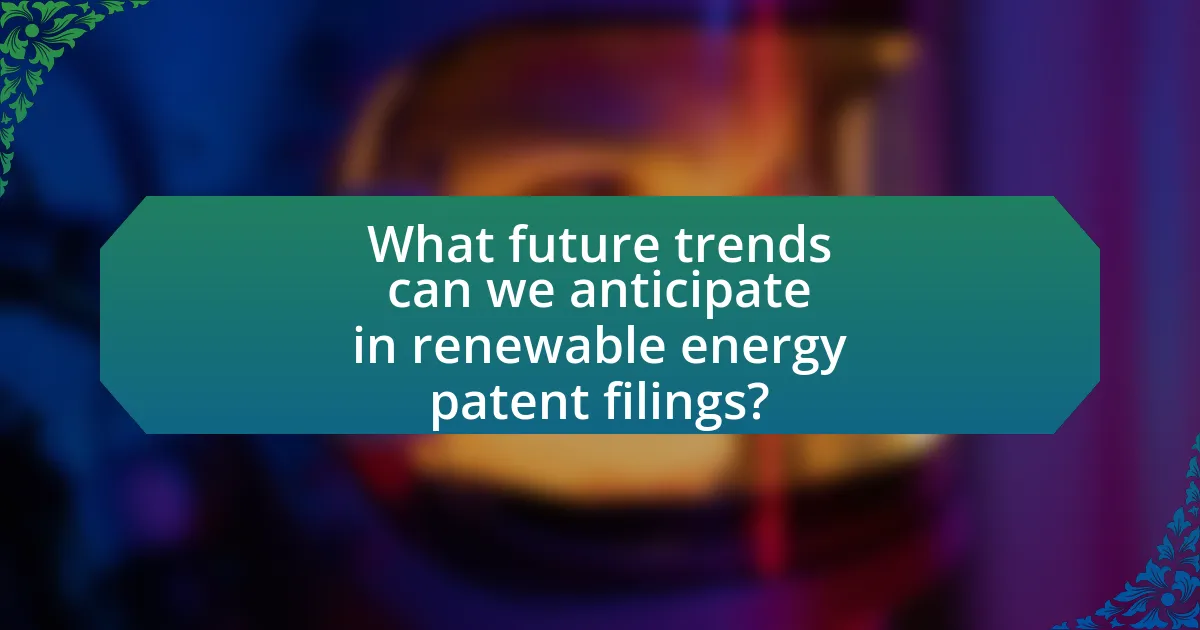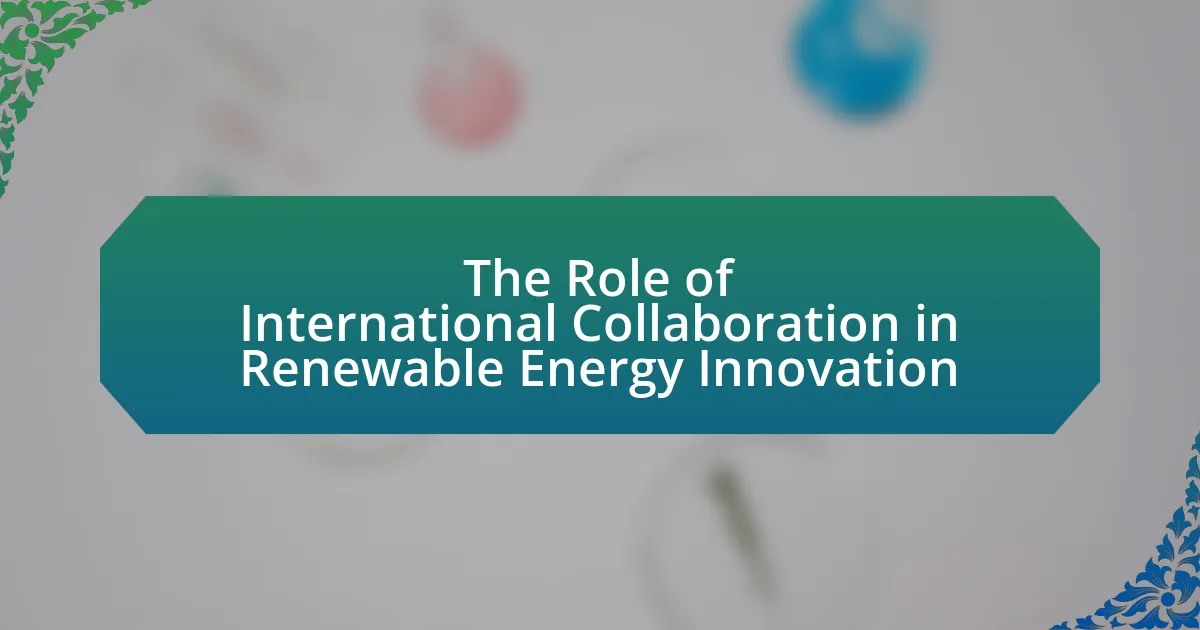The article focuses on trends in renewable energy patent filings and their implications for the industry. It highlights a significant increase in patent applications, particularly in solar, wind, and energy storage technologies, with solar energy patents accounting for approximately 40% of the total. The article discusses the factors influencing these trends, including technological advancements, regulatory changes, and market demand, while also examining the geographical distribution of patent activity, the disparity between developed and developing countries, and the role of government policies. Additionally, it addresses the challenges companies face in navigating patent laws and the strategies they employ to leverage patents for competitive advantage, ultimately emphasizing the importance of innovation in shaping the future of the renewable energy sector.

What are the current trends in renewable energy patent filings?
Current trends in renewable energy patent filings indicate a significant increase in innovation, particularly in solar, wind, and energy storage technologies. According to the World Intellectual Property Organization (WIPO), renewable energy patent applications have surged by over 50% in the last decade, reflecting a growing emphasis on sustainable energy solutions. Notably, solar energy technologies dominate this trend, accounting for approximately 40% of all renewable energy patents filed globally. Additionally, advancements in battery technology and energy efficiency solutions are gaining traction, with a notable rise in patents related to lithium-ion batteries and smart grid technologies. This upward trajectory in patent filings underscores the industry’s shift towards more efficient and sustainable energy systems, driven by both technological advancements and regulatory support for clean energy initiatives.
How have patent filings in renewable energy evolved over the past decade?
Patent filings in renewable energy have significantly increased over the past decade, reflecting a growing emphasis on innovation in this sector. According to the World Intellectual Property Organization (WIPO), renewable energy patent applications rose by approximately 50% from 2010 to 2020, with solar and wind technologies leading this surge. This trend indicates a robust investment in research and development, driven by global efforts to combat climate change and transition to sustainable energy sources. The increase in patent filings not only highlights technological advancements but also suggests a competitive landscape among companies and countries aiming to secure intellectual property rights in renewable energy technologies.
What factors have influenced the increase or decrease in patent filings?
The increase or decrease in patent filings is influenced by technological advancements, regulatory changes, and market demand. Technological advancements, such as innovations in solar and wind energy, have led to a surge in patent applications, with the International Energy Agency reporting a 20% increase in renewable energy patents from 2018 to 2020. Regulatory changes, including government incentives for clean energy, have also spurred filings, as seen in the U.S. with the extension of tax credits for renewable energy projects. Conversely, economic downturns can lead to a decrease in filings, as companies may cut research and development budgets, evidenced by a 15% drop in patent filings during the 2008 financial crisis.
Which renewable energy sectors are seeing the most patent activity?
The renewable energy sectors seeing the most patent activity are solar energy, wind energy, and energy storage technologies. According to the World Intellectual Property Organization (WIPO), solar energy patents have surged significantly, with a 20% increase in filings over the past five years. Wind energy has also experienced robust growth, particularly in offshore wind technologies, which saw a 15% rise in patent applications. Additionally, energy storage technologies, especially battery innovations, have become a focal point, with a 25% increase in patents filed, reflecting the industry’s shift towards integrating renewable sources with efficient storage solutions.
What geographical regions are leading in renewable energy patent filings?
The geographical regions leading in renewable energy patent filings are North America, Europe, and Asia, particularly China. According to the World Intellectual Property Organization (WIPO), China accounted for over 50% of global renewable energy patent applications in recent years, significantly outpacing other regions. The United States and Germany follow, with substantial contributions to solar and wind energy technologies, reflecting their strong investment in research and development in the renewable sector.
How do patent filings in developed countries compare to developing countries?
Patent filings in developed countries significantly outnumber those in developing countries, reflecting a disparity in innovation capacity and investment in research and development. For instance, in 2020, the United States and China accounted for over 70% of global patent filings, while many developing nations contributed less than 1% collectively. This trend indicates that developed countries have more robust legal frameworks, funding, and infrastructure to support innovation, leading to higher patent activity in sectors like renewable energy.
What role do government policies play in shaping patent trends in different regions?
Government policies significantly influence patent trends across different regions by establishing regulatory frameworks, providing financial incentives, and promoting research and development. For instance, countries with strong intellectual property protections, such as the United States, tend to see higher rates of patent filings in renewable energy technologies, as these policies encourage innovation and investment. In contrast, regions with less robust patent systems may experience lower patent activity, as inventors may lack confidence in the protection of their inventions. Additionally, government initiatives, such as subsidies for renewable energy projects or tax credits for research, can directly stimulate patent filings by making it financially viable for companies to invest in new technologies. For example, the European Union’s Green Deal aims to boost clean energy innovation, which has led to a surge in related patent applications. Thus, the interplay between government policies and patent trends is crucial in shaping the landscape of renewable energy innovation.
What types of technologies are most commonly patented in the renewable energy sector?
The most commonly patented technologies in the renewable energy sector include solar photovoltaic systems, wind turbine designs, bioenergy processes, and energy storage solutions. Solar photovoltaic systems account for a significant portion of patents due to advancements in efficiency and materials, with the International Energy Agency reporting that solar energy capacity has grown rapidly, leading to increased innovation. Wind turbine designs have also seen substantial patent activity, driven by the need for improved efficiency and reduced costs, as evidenced by the Global Wind Energy Council’s data showing a steady increase in installed wind capacity. Bioenergy processes, including biomass conversion and biogas production, are frequently patented as they offer sustainable alternatives to fossil fuels. Additionally, energy storage technologies, particularly lithium-ion batteries and other innovative storage solutions, are critical for balancing supply and demand in renewable energy systems, with the U.S. Department of Energy highlighting the importance of these technologies in enhancing grid reliability.
What innovations are driving the growth of patent filings in renewable energy?
Innovations in renewable energy driving the growth of patent filings include advancements in solar technology, energy storage solutions, and wind turbine efficiency. For instance, the development of bifacial solar panels, which capture sunlight on both sides, has led to increased efficiency and a surge in patent applications. Additionally, breakthroughs in lithium-ion battery technology and solid-state batteries have significantly improved energy storage capabilities, resulting in a higher volume of patents filed. Furthermore, innovations in offshore wind turbine design, such as floating turbines, have expanded the potential for wind energy generation, contributing to the rise in patent filings in this sector. These innovations reflect a broader trend towards enhancing efficiency and sustainability in renewable energy technologies.
How do these technologies impact the overall renewable energy landscape?
Technologies significantly reshape the renewable energy landscape by enhancing efficiency, reducing costs, and fostering innovation. For instance, advancements in solar panel technology, such as bifacial panels, have increased energy capture by up to 27%, according to the National Renewable Energy Laboratory. Similarly, improvements in wind turbine design, including larger rotor diameters, have led to a 50% increase in energy production in some cases. These innovations drive competition, attract investment, and accelerate the transition to sustainable energy sources, ultimately contributing to global climate goals.

What are the implications of these trends for the renewable energy industry?
The implications of trends in renewable energy patent filings for the renewable energy industry include increased innovation, competitive advantage, and market growth. As patent filings rise, companies are likely to invest more in research and development, leading to technological advancements that enhance efficiency and reduce costs. For instance, a report from the International Renewable Energy Agency (IRENA) indicates that global renewable energy patents increased by 20% from 2019 to 2020, reflecting a surge in innovation. This trend not only fosters competition among firms but also attracts investment, as stakeholders recognize the potential for profitability in a rapidly evolving market. Consequently, the renewable energy sector is positioned for significant expansion, driven by the continuous influx of new technologies and solutions.
How do patent trends affect competition within the renewable energy market?
Patent trends significantly influence competition within the renewable energy market by determining the pace of innovation and the barriers to entry for new firms. A high volume of patent filings indicates active research and development, which can lead to technological advancements that enhance efficiency and reduce costs. For instance, according to the International Renewable Energy Agency, the number of patents in solar energy technologies increased by over 50% from 2010 to 2020, reflecting intense competition among firms to secure market share and technological leadership. This competitive landscape can result in both collaboration and rivalry, as established companies may seek to license technologies from startups, while also engaging in aggressive patenting strategies to protect their innovations. Consequently, patent trends shape the dynamics of competition, influencing market structure and the ability of firms to differentiate their offerings.
What strategies are companies employing to leverage patent filings for competitive advantage?
Companies are employing strategies such as aggressive patent portfolios, strategic partnerships, and defensive patenting to leverage patent filings for competitive advantage. By building extensive patent portfolios, companies can protect their innovations and create barriers to entry for competitors, as seen in the renewable energy sector where firms like Tesla and Siemens have filed numerous patents to secure their technologies. Strategic partnerships allow companies to share resources and knowledge, enhancing their innovation capabilities while also expanding their patent coverage. Additionally, defensive patenting helps companies safeguard against litigation by acquiring patents that could potentially be used against them, thus maintaining their market position. These strategies collectively enable companies to enhance their competitive edge in the rapidly evolving renewable energy landscape.
How do patent trends influence investment in renewable energy technologies?
Patent trends significantly influence investment in renewable energy technologies by indicating innovation potential and market viability. A rise in patent filings often signals increased research and development activity, attracting investors who seek to capitalize on emerging technologies. For instance, the International Renewable Energy Agency reported a 20% increase in global renewable energy patent applications from 2010 to 2020, correlating with a surge in venture capital investments in the sector. This trend demonstrates that a robust patent landscape can enhance investor confidence, as it suggests a competitive edge and future profitability in renewable energy markets.
What challenges do companies face regarding patent filings in renewable energy?
Companies face several challenges regarding patent filings in renewable energy, primarily including high costs, complex regulations, and rapid technological advancements. The high costs associated with patent applications can deter smaller companies from pursuing patents, as legal fees and application expenses can be significant. Additionally, the complex regulatory landscape varies by country, making it difficult for companies to navigate the requirements for patent protection in different jurisdictions. Rapid technological advancements in renewable energy create a fast-paced environment where innovations can quickly become obsolete, complicating the patenting process and increasing the risk of infringement. These challenges are supported by data indicating that patent filings in renewable energy have fluctuated due to these factors, highlighting the need for companies to adapt their strategies accordingly.
How can companies navigate the complexities of patent laws and regulations?
Companies can navigate the complexities of patent laws and regulations by employing a combination of legal expertise, strategic planning, and continuous education. Engaging patent attorneys who specialize in renewable energy can provide insights into specific regulations and help in drafting robust patent applications that comply with legal standards. Additionally, companies should conduct thorough patent searches to identify existing patents and avoid infringement, which is crucial in a rapidly evolving field like renewable energy. Regularly attending industry seminars and workshops can also keep companies informed about changes in patent laws and emerging trends, ensuring they remain compliant and competitive.
What are the risks associated with patent infringement in the renewable energy sector?
Patent infringement in the renewable energy sector poses significant risks, including legal liabilities, financial penalties, and damage to reputation. Companies found infringing patents may face lawsuits that can result in costly settlements or judgments, which can reach millions of dollars, as seen in cases involving major renewable energy firms. Additionally, patent infringement can lead to injunctions that halt production or sales of infringing products, disrupting business operations and market presence. The renewable energy sector, characterized by rapid innovation, also faces the risk of increased scrutiny from competitors and regulatory bodies, which can further complicate compliance and operational strategies.
How do patent trends impact innovation in renewable energy?
Patent trends significantly influence innovation in renewable energy by providing a framework for protecting intellectual property, which encourages investment and research. When patent filings increase in renewable energy technologies, it indicates a growing interest and potential for commercialization, leading to more funding and resources allocated to innovative projects. For instance, a report from the World Intellectual Property Organization (WIPO) noted that global patent applications in renewable energy technologies surged by 25% from 2010 to 2019, reflecting heightened innovation activity in solar, wind, and bioenergy sectors. This increase in patents not only fosters competition but also facilitates knowledge sharing, as companies often build upon existing patented technologies to develop new solutions, thereby accelerating advancements in the field.
What role do patents play in fostering or hindering technological advancements?
Patents play a dual role in technological advancements, both fostering innovation and potentially hindering it. On one hand, patents incentivize inventors by granting exclusive rights, which can lead to increased investment in research and development; for example, the renewable energy sector has seen a significant rise in patent filings, indicating a robust interest in innovation. On the other hand, patents can create barriers to entry, as they may limit access to essential technologies, thereby slowing down the overall pace of advancement. A study by the World Intellectual Property Organization (WIPO) highlights that while patents can stimulate innovation, overly broad or numerous patents in a field can lead to a phenomenon known as “patent thickets,” which complicates the development and commercialization of new technologies.
How can collaboration and open innovation mitigate patent-related challenges?
Collaboration and open innovation can mitigate patent-related challenges by fostering knowledge sharing and reducing the risk of infringement. When organizations collaborate, they can pool resources and expertise, leading to the development of technologies that are less likely to infringe on existing patents. For instance, the Solar Energy Industries Association reported that collaborative research initiatives in solar technology have led to innovations that navigate around existing patents, thus minimizing legal disputes. Additionally, open innovation platforms allow companies to access a broader range of ideas and solutions, which can lead to alternative approaches that avoid patent conflicts. This collaborative environment not only accelerates innovation but also enhances the overall efficiency of the patent system by encouraging transparency and shared advancements in renewable energy technologies.

What future trends can we anticipate in renewable energy patent filings?
Future trends in renewable energy patent filings indicate a significant increase in innovations related to energy storage, smart grid technologies, and offshore wind energy. The global shift towards decarbonization and sustainability is driving companies and research institutions to invest heavily in these areas, as evidenced by a 25% rise in patent applications in energy storage technologies from 2018 to 2022. Additionally, advancements in artificial intelligence and machine learning are expected to enhance the efficiency of renewable energy systems, leading to a surge in related patent filings. This trend reflects the industry’s response to growing energy demands and the need for more efficient, reliable renewable energy solutions.
What emerging technologies are likely to dominate future patent filings?
Emerging technologies likely to dominate future patent filings include artificial intelligence, blockchain, and advanced renewable energy solutions such as solar and wind innovations. The increasing integration of artificial intelligence in various sectors is driving a surge in patent applications related to machine learning algorithms and automation processes. Blockchain technology is also gaining traction, particularly in supply chain management and energy trading, leading to a rise in related patent filings. Furthermore, advancements in renewable energy technologies, such as improved solar panel efficiency and innovative wind turbine designs, are expected to see significant patent activity as the global demand for sustainable energy solutions continues to grow. According to the World Intellectual Property Organization, patent filings in renewable energy technologies have increased by over 20% in recent years, highlighting the sector’s rapid innovation and investment.
How might advancements in energy storage influence patent activity?
Advancements in energy storage are likely to significantly increase patent activity as companies and researchers seek to protect innovative technologies and methods. The growing demand for efficient energy storage solutions, driven by the rise of renewable energy sources, has led to a surge in research and development efforts. For instance, the global energy storage market is projected to reach $546 billion by 2035, prompting firms to file patents to secure competitive advantages. Additionally, the International Energy Agency reported a 50% increase in energy storage patents from 2015 to 2020, indicating a clear trend towards innovation in this sector. This heightened patent activity reflects the strategic importance of energy storage technologies in achieving energy transition goals and enhancing grid reliability.
What role will digital technologies play in shaping future patent trends?
Digital technologies will significantly influence future patent trends by enhancing the efficiency and accessibility of the patent application process. Technologies such as artificial intelligence and blockchain are streamlining patent searches, improving the accuracy of prior art assessments, and facilitating secure transactions and record-keeping. For instance, AI algorithms can analyze vast databases of existing patents to identify novel inventions, thereby accelerating the examination process. Additionally, blockchain technology can provide transparent and tamper-proof records of patent ownership and licensing, which is crucial in the renewable energy sector where innovation is rapid and collaboration is common. These advancements are expected to lead to an increase in patent filings, as inventors and companies can navigate the patent landscape more effectively and protect their innovations with greater confidence.
How can companies prepare for the evolving landscape of renewable energy patents?
Companies can prepare for the evolving landscape of renewable energy patents by actively monitoring patent trends and investing in research and development. By analyzing patent filings, companies can identify emerging technologies and potential competitors, allowing them to adapt their strategies accordingly. For instance, the World Intellectual Property Organization reported a significant increase in renewable energy patent applications, indicating a growing competitive landscape. Additionally, companies should engage in strategic partnerships and collaborations to enhance their innovation capabilities and share resources, which can lead to more robust patent portfolios. This proactive approach not only positions companies to capitalize on new opportunities but also mitigates risks associated with patent infringement and market shifts.
What best practices should companies adopt for effective patent management?
Companies should adopt a systematic approach to patent management that includes regular audits, strategic filing, and active monitoring of patent portfolios. Regular audits help identify valuable patents and those that may no longer be relevant, ensuring resources are allocated efficiently. Strategic filing involves aligning patent applications with business goals and market trends, particularly in the rapidly evolving renewable energy sector, where innovation is crucial. Active monitoring of patent portfolios allows companies to track competitors and emerging technologies, enabling timely adjustments to their strategies. According to a study by the World Intellectual Property Organization, effective patent management can lead to a 20% increase in innovation output, highlighting the importance of these best practices.
How can organizations foster a culture of innovation to enhance patent filings?
Organizations can foster a culture of innovation to enhance patent filings by implementing structured innovation programs that encourage creativity and collaboration among employees. These programs can include regular brainstorming sessions, cross-departmental teams, and incentives for idea generation, which have been shown to increase engagement and lead to more innovative solutions. For instance, a study by the Harvard Business Review found that companies with formal innovation processes are 30% more likely to achieve significant patent filings compared to those without such structures. By prioritizing a supportive environment that values experimentation and risk-taking, organizations can significantly boost their patent output in the renewable energy sector.
What are the key takeaways for stakeholders in the renewable energy sector?
Key takeaways for stakeholders in the renewable energy sector include the necessity to innovate and adapt to emerging technologies, as evidenced by a significant increase in patent filings, which rose by 20% from 2019 to 2022. This trend indicates a competitive landscape where intellectual property is crucial for maintaining market position. Additionally, stakeholders should focus on collaboration and partnerships, as joint ventures have been shown to accelerate technology development and deployment, enhancing overall industry growth. Furthermore, understanding regulatory changes and consumer preferences is vital, as these factors directly influence investment decisions and market opportunities in the renewable energy sector.
How can stakeholders leverage patent trends for strategic planning?
Stakeholders can leverage patent trends for strategic planning by analyzing the frequency and focus of patent filings in renewable energy technologies. This analysis allows stakeholders to identify emerging technologies, assess competitive landscapes, and forecast market shifts. For instance, a surge in patents related to solar energy efficiency indicates a growing market opportunity, prompting stakeholders to allocate resources accordingly. Additionally, tracking patent citations can reveal which innovations are gaining traction, guiding investment decisions. Historical data shows that companies that align their strategies with patent trends often achieve higher market shares and better innovation outcomes, as evidenced by the rise of firms that invested in battery technology patents during the electric vehicle boom.
What common pitfalls should companies avoid in their patent strategies?
Companies should avoid the pitfalls of inadequate prior art searches, overly broad claims, and neglecting international patent protection in their patent strategies. Inadequate prior art searches can lead to the rejection of patent applications or invalidation of granted patents, as evidenced by the high percentage of patents that face challenges during litigation. Overly broad claims can result in increased scrutiny and potential rejection by patent offices, as seen in cases where companies have faced difficulties in enforcing patents due to vague language. Additionally, neglecting international patent protection can limit market opportunities and expose companies to competition in foreign markets, as global patent filings have increased significantly, reflecting the need for comprehensive strategies.




